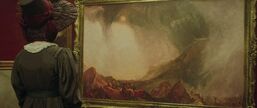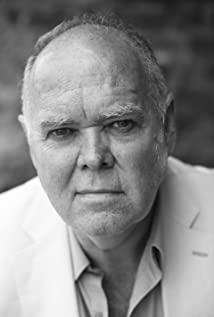Most of McLee's works that I often read in the past are mostly concerned with the plight of life at the bottom of modern British society, with very distinct role-building, life-filled performances and detailed descriptions , the open narrative still has quite obvious stories and propositions. The theme of this new work "Mr. Turner" is the life of the 19th century British painter William Turner in his later years. The distance and time span of the times are quite rare in the director's past works (I haven't seen "Song of Songs" yet). ” so the comparison cannot be discussed). The subject matter of celebrity biographies involves a lot of historical background, especially I am not familiar with William Turner's creation or painting art, there is an innate threshold to enter the story line, and the film itself does not have a clear story line, but The loose silhouette of the protagonist's life, paragraph after paragraph, is really not easy to grasp for a while.
Intuitively, the obvious proposition is to see the process of Turner moving towards the end of his life, depicting the difficulties and transitions of his life, art and emotions, thus forming the image of Turner as an ordinary person, and the director's views on his life. Perspectives and reflections on life. It is a very large and open description. However, at the end, Turner's last words before his death may be used as a starting point for thinking: The Sun is God, the sun is God (the holy scriptures?), after he spit out this sentence, he swallowed his last breath, and the next scene is It is back to the figure he sketched facing the setting sun before his death. This shot not only echoes the attitude of his depiction of the rising sun at the beginning of the film, but even in the impression that this is the first time the sun actually appears in the picture. As a painter, the light and shadow of nature is of course his heart, and the changes of light and shadow brought by sunlight are overflowing in the exquisite photography of the whole film. It is a breathtaking piece, and it also corresponds to the eternal theme of Turner's paintings in the film: the mutual reflection of sunset, sky and ocean.
In order to capture the light and seascape, Turner traveled frequently, and his walking posture with his suitcase on his back became one of the most vivid impressions in the film, which not only reflected the details of his art and life, but also became an important story. Line: He visited a seaside B&B many times, and then Mrs. Booth, the owner of the B&B, became his lover in his later years. Finally, Turner died in the house he rented for the two of them, accompanied by Mrs. Booth. . This seemingly touching twilight relationship also contrasts with Turner's dark side. Not only has he abandoned his former wife, he has never mentioned that he has two daughters, and he didn't even attend the funeral when one of his daughters died. . Returning to his London residence at the end of each trip, the film implies that he has a physical relationship from time to time with the maid who has taken care of him for years.
The last two scenes of the film, one is Mrs. Booth wiping the window and smiling in the sunset (I don't know if she is looking at Turner's figure or thinking about him who just passed away), which seems to be the happiest moment of Turner's later years. One shot is back to the solitary figure of the maid in the gloomy studio of Turner's London residence. These two women can be said to represent the two faces of Turner, especially the film deliberately shows the skin on the maid's face that gradually festered with age, and the darkness that he was abandoned after Turner died. It is the light and shadow of the sun.
This is never a romantic biography of an artist. Timothy Spall's performance of Turner in his later years is fat and vulgar. His tone of voice is deliberately suppressed to highlight the unpleasant guttural tone. Turner's father appears at first glance in the first half of the film. It doesn't matter how old the son is, but as his body gradually weakens, the film also sees his father's constant coughing and old age from the protagonist's point of view, and to a certain extent it is like a preview of his own death. After the death of his father, there are two descriptions of sex, one is that Turner has sex with the maid in a semi-forced rough manner, and the other is that he goes to the brothel and asks the prostitute to put on a desperate pose for him to draw, both of which are like mourning. The emotional transformation brought about by his father's grief vented. Interestingly, he confessed to Mrs. Booth afterwards. The causal relationship between them cannot be determined because of the narrative style of the clip. And the death imagery of young women appeared more than once, from the young prostitute lying down, to the death of his daughter, to the corpse of the drowning girl he witnessed in the port when he was sick in bed in his later years (he also wanted to draw her) , the meaning of which remains to be considered.
Many recurring fragments of the film can accumulate the meaning of different faces. For example, the small gallery in Turner's house is witnessing the aging of the protagonist, or the exhibitions he participated in many times from the position of the painting to the peers. The comments in between and the details of his on-site modification of the pictures all describe a certain power relationship in the art world, the ebb and flow of his artistic status and the change of his creative attitude. There is also his counter-attack against the artistic conception of young painting fans who wantonly criticize the previous generation of masters. Several battle scenes between him and another down-and-out painter Hayden are also worth pondering: at first, he criticized Hayden with others, and then he avoided Watching everyone in the exhibition hall quarreled with Hayden, who was excluded, in the end he canceled the debt that Hayden owed him. First, Turner's gradually abstract paintings (because of his eyesight?) also suffered from the same problem. The ridicule and criticism of public opinion, and secondly, I wonder if he can finally empathize with the sufferings of their lives?
The last thing worth remembering is that there are two "scientific" passages in the film that also play the trick of light. One is that a female friend of Turner held a lens and refracts a rainbow on the canvas at the beginning of the film. She passes through different colors. Experiments with light made the metal magnetic (not sure about the physics of it). The other is in the latter part of the film Turner was amazed by the newly invented camera, which could record light and shadow on the negative in only ten seconds. second photo. For a painter, this is a moment of complex feelings. He uses his body and time to chase light constantly and transform it on the canvas, but it takes only ten seconds for science to accomplish the same thing. Of course, from an artistic point of view, both are Quite different, but in the attempt to pursue eternity as a person, these passages record the changes in light and shadow art in history, especially it is said that this film is the first time that Mike Lee used digital shooting, from canvas to film photography to digital film, watching the moment suddenly A sense of time travel.
"Mr. Turner" is not an easy movie to enter, but seeing the intertwined contrast of light and shadow in Turner's life at the end, so full of sunshine and so dark, it can be "Careless" or "Another" Years" or think of all the director's other works, this is indeed McLee's pessimistic cruel and warm view of life, with Turner's life, paintings and the light and shadow under the lens frozen in the film, which is unforgettable.
(2015/6/20)
View more about Mr. Turner reviews











